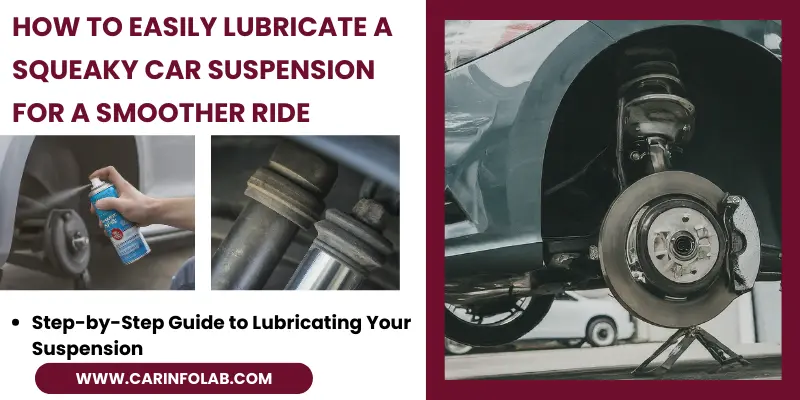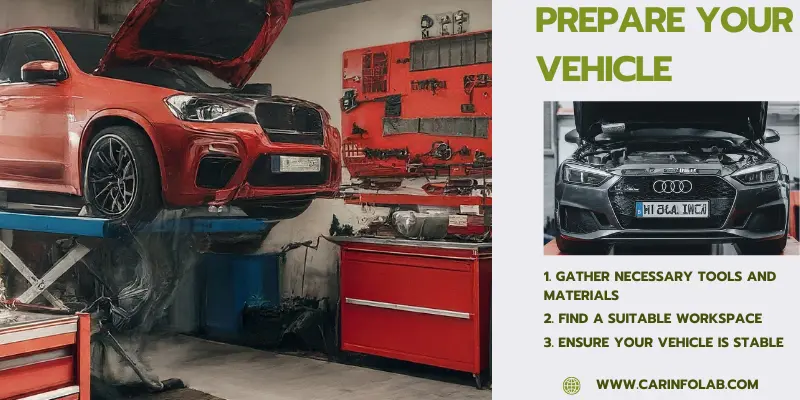How to Easily Lubricate a Squeaky Car Suspension for a Smoother Ride? 6 Steps
Updated: September 28, 2024
135
A squeaky car suspension can be a nuisance. It often signals that your vehicle needs some attention. Thankfully, lubricating your suspension is a straightforward task you can tackle on your own. Car suspension also affects the speed of the car. This article will guide you through the process step by step, ensuring you can enjoy a smoother ride without any annoying sounds.
Understanding Car Suspension
Before we dive into the lubrication process, let’s understand what car suspension is. The suspension system connects your car’s body to its wheels. Roll suspension works well on an older car also. It plays a crucial role in:
- Absorbing shocks from the road.
- Providing stability when turning.
- Ensuring comfort during your drive.
Over time, parts of the suspension can wear out, leading to squeaks and other noises. This is often due to a lack of lubrication in the joints and bushings. In Richmond County, many car suspension specialists adjust your car effectively.

Why Does Your Suspension Squeak?
Squeaking noises can come from various parts of the suspension system. Here are some common causes:
- Dry bushings: The rubber bushings can dry out and become brittle over time.
- Worn-out parts: Components like shock absorbers can wear down, causing noise.
- Lack of lubrication: Joints and pivots need proper lubrication to function smoothly.
- Ball Joints Issues: Ball joints connect the suspension to the wheels, allowing for smooth movement.
- Loose or Damaged Components: Various components of the suspension system can become loose or damaged over time.
- Rust and Corrosion: Rust can develop on metal parts of the suspension system, especially in areas exposed to moisture and salt.
- Worn Suspension Springs: Springs support the weight of the vehicle and absorb shocks from the road.
Understanding these causes helps you identify the right solutions. Now, let’s focus on how to lubricate your squeaky suspension.
Tools and Materials Needed
Before you start, gather the following tools and materials:
| Tool/Material | Purpose |
|---|---|
| Lubricant (silicone or grease) | To lubricate suspension joints and bushings. |
| Wrench set | Jack and Jack stands |
| Jack and jack stands | To lift the vehicle safely. |
| Clean cloth | For wiping off excess lubricant. |
| Safety glasses | To protect your eyes during the process. |
Step-by-Step Guide to Lubricating Your Suspension
Prepare Your Vehicle
Before you begin any work on your car, safety comes first.
1. Gather Necessary Tools and Materials
Before you start any work, ensure you have all the tools and materials you’ll need. Common items include:
- Lubricants:
- High-quality suspension grease or lubricant
- WD-40 or silicone spray for easier access to tight areas
- Safety Equipment:
- Gloves to protect your hands
- Safety goggles to shield your eyes
2. Find a Suitable Workspace
Choose a safe and well-lit location to work on your vehicle. Options include:
- Garage: A garage provides shelter from the elements and offers good lighting.
- Driveway: If you don’t have a garage, ensure your driveway is level and free of debris.
- Parking Lot: A quiet parking lot can also work, but make sure you’re not obstructing traffic.
3. Ensure Your Vehicle is Stable
Before working on your vehicle, make sure it is stable to prevent accidents:
- Ensures that the vehicle won’t roll away while you’re working.
- Always set the parking brake to prevent movement.
- If necessary, place wheel chocks behind the rear wheels for extra safety, especially if you’re working on the front suspension.
4. Check Vehicle Manuals
Consult your vehicle’s owner’s manual for specific instructions on the suspension system:
- Identify Components: The manual can help you locate the suspension parts that may need lubrication.
- Follow Manufacturer Guidelines: Check the recommended lubricants and procedures for your specific make and model.
Inspect the Suspension
Before applying lubricant, take a moment to inspect your suspension.
- Look for any worn-out parts.
- Check for cracks or damage on the bushings and joints.
- Note any areas that need special attention.
Clean the Joints and Bushings
Before lubrication, it’s important to clean the joints.
| Step | Action |
|---|---|
| Inspect the Components | Look for Damage: Check the joints and bushings for wear, cracks, or damage. If they’re worn out, think about replacing them instead of cleaning. |
| Apply Cleaner | Spray Cleaner: Apply your degreaser or cleaning solution generously to the joints and bushings. Let it sit for a few minutes to break down the grime. |
| Scrub Away Grime | Scrub: Use a brush to gently clean the joints and bushings, focusing on dirty areas. Rinse: If you used a water-based cleaner, rinse with clean water. |
| Wipe Down | Dry Off: Use a lint-free cloth to wipe the cleaned areas dry, preventing any moisture that could cause rust. |
Apply the Lubricant
Now it’s time to apply the lubricant.
1. Choosing the Right Lubricant
- Types of Lubricants: Depending on the specific parts of your suspension, you can use different types of lubricants. Common options include:
- Grease: Ideal for ball joints and bushings. It provides long-lasting lubrication and protects against moisture and dirt.
- Silicone Spray: Good for rubber parts and can help reduce noise while providing a protective layer.
- WD-40: Useful for quick fixes but not a long-term solution. It can help loosen squeaks temporarily.
| Type of Lubricant | Frequency of Application | Typical Lifespan | Effectiveness |
|---|---|---|---|
| Grease | Every 6 months or as needed | 1-2 years | Excellent for reducing friction and wear. Ideal for heavy-duty use. |
| Silicone Spray | Every 3 months or as needed | 6 months – 1 year | Good for noise reduction; works well on rubber components. |
| WD-40 | As needed for squeaks | Temporary (a few days) | Effective for loosening rust and moisture but not a long-term solution. |
2. Applying Lubricant to the Joints
Step 1: Locate the Joints
- Identify the areas where the joints are located, such as ball joints, tie rod ends, and control arm joints.
Step 2: Apply the Grease
- Using a Grease Gun: If you’re using grease, connect the grease gun to the fitting on the joint.
- Squeeze Gently: Apply grease slowly until you see it oozing out of the joint. This indicates that the joint is well-lubricated.
- Avoid Over-Lubrication: Be careful not to overfill, as excess grease can attract dirt and debris.
3. Lubricating the Bushings
- Identify the Bushings
- Use a Brush or Spray
- Coat Evenly
- Wipe Away Excess Lubricant

Test the Suspension
After applying the lubricant, it’s time to test your work.
- Lower the vehicle: Carefully remove the jack stands and lower the vehicle back to the ground.
- Take a short drive: Drive around the block to test the suspension. Listen for any remaining squeaks.
- Bounce Test: The bounce test is a quick way to assess the condition of your suspension:
- Perform the Test:
- Push down firmly on the front or rear of the vehicle.
- Release and observe how the car reacts.
- Interpret the Results:
- If the vehicle bounces back up and settles quickly, the suspension is likely functioning well.
- If the vehicle continues to bounce several times, it may indicate worn-out shocks or struts.
- Perform the Test:
- Check Wheel Alignment
Regular Maintenance
Lubricating your suspension isn’t a one-time task. Regular maintenance will keep your car in top shape.
- Check every few months: Regularly inspect and lubricate your suspension.
- Listen for changes: If the squeaks return, repeat the lubrication process.
Benefits of Lubricating Your Suspension
| Benefits |
|---|
|
Common Mistakes to Avoid
| Common Mistakes |
|---|
|
Conclusion
Lubricating a squeaky suspension is an essential part of car maintenance. By following these simple steps, you can ensure a smoother ride and extend the life of your suspension components. Regular checks, and proper cleaning of car suspension and maintenance will not only save you money but also enhance your driving experience.
Remember, keeping your car in good shape is a worthwhile investment. So, grab your tools and give your suspension the care it needs for a comfortable and enjoyable ride!
FAQs
How often should I lubricate my suspension?
It’s a good idea to check and lubricate your suspension every 3-6 months, or whenever you notice squeaks.
Can I use any lubricant for my suspension?
No, it’s best to use a lubricant designed for automotive use, such as silicone spray or grease.
What if the squeaking continues after lubrication?
If squeaks persist, it may indicate worn-out parts. In that case, consult a mechanic for further inspection.
Is it safe to work under a lifted vehicle?
Always use jack stands to secure the vehicle when lifting it. Never rely solely on a jack for support.
How can I tell if my suspension needs more lubrication?
If you hear squeaks or notice a rough ride, it may be time to inspect and lubricate your suspension.
Please Write Your Comments